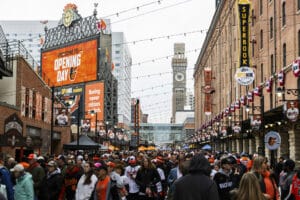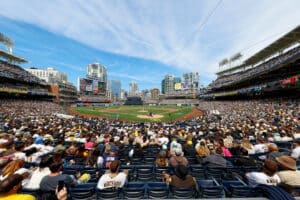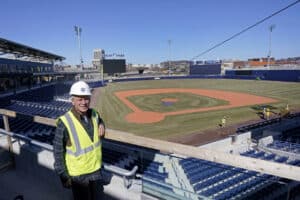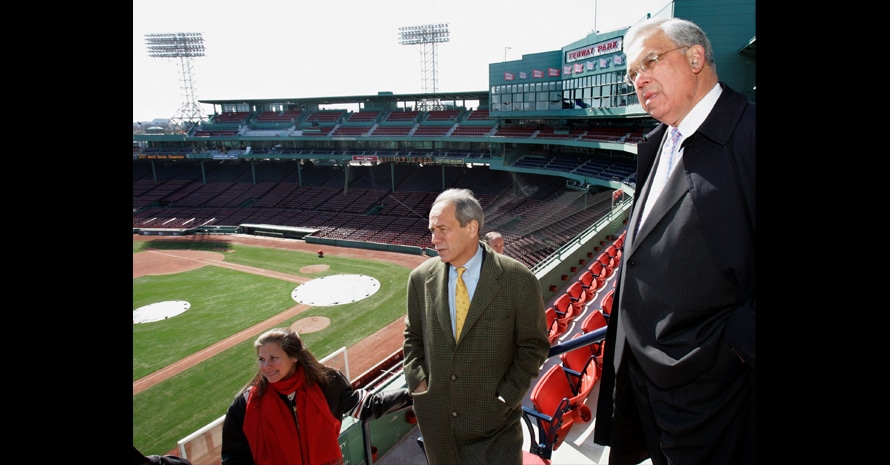BOSTON’S FINEST: In this 2008 photo, Janet Marie Smith, bottom left, joins Larry Lucchino, center, and Tom Menino, Boston’s mayor at the time, on a tour of Fenway Park renovations. (AP Photo)
Lucchino put his stamp on multiple MLB venues
Larry Lucchino, a visionary baseball executive who helped break the mold for ballpark development and strategically positioned stadiums to revitalize cities’ urban core, died on Tuesday. He was 78.
As president of the Baltimore Orioles, San Diego Padres and the Boston Red Sox, Lucchino spearheaded the landmark development of Oriole Park at Camden Yards, and later, Petco Park, and led the effort to preserve Fenway Park, MLB’s oldest facility that opened in 1912.
Janet Marie Smith, a ballpark developer and urban planner, spoke with VenuesNow about Lucchino’s legacy and what fueled their professional relationship over the past 35 years. Smith and Lucchino were tied at the hip for reinventing the ballpark model, in tandem with designers such as Joe Spear at the old HOK Sport, the architect for Oriole Park and Petco Park.
Smith, now the Los Angeles Dodgers’ executive vice president of planning and development, serves as an advisor to the Pittsburgh Pirates as they renovate PNC Park, considered to be among MLB’s jewels since it opened 23 years ago. She’s in Pittsburgh this week as the Pirates prepare for Opening Day on Friday.
“There’s something a little poetic about it, because Larry was from Pittsburgh and always loved the city and his long tether to it,” Smith said. “It’s no understatement to say that he changed the course of baseball history with his vision of what he wanted Camden Yards to be and it was based on his personal experiences growing up in Pittsburgh and what (old) Forbes Field meant to him.”
Lucchino hired Smith in the late 1980s to help plan Camden Yards, which opened in 1992. The ballpark was authentic to its site, connected to an old railroad warehouse, rich in design details such as the weather vanes attached to the old-school scoreboard in center field. Thirty-two years later, the building maintains its charm as the O’s, in conjunction with the Maryland Stadium authority, gave it a periodic refresh.

ORIOLES ROOST: Baseball fans walk down Eutaw Street at Camden Yards for the Baltimore Orioles’ 2024 regular-season opener on March 28. (AP Photo)
Big picture, the downtown Baltimore project stands among the first retro-themed ballparks and a departure from the stale, cookie-cutter multipurpose stadiums of the 1970s. It resulted in a trend for teams building downtown ballparks over the next three decades, including the Cleveland Indians, Arizona Diamondbacks, Colorado Rockies, Cincinnati Reds and Houston Astros.
Smith had studied the city of Baltimore during her urban planning school days at City College of New York and knew of its reputation of reinventing itself over the years.
At first thought, Smith didn’t want to see the Orioles leave Memorial Stadium, “kind of a nice, old-shoe ballpark,” she said. But in delving deeper into the project, she understood Lucchino’s vision to help re-establish downtown Baltimore as a destination after its financial district and some industries had evaporated over time.
It was all about forming the next chapter for Baltimore with the ballpark serving as the anchor, Smith said.
Lucchino recognized the importance Fenway Park and Wrigley Field, which opened in 1914, held for the sport, Smith said. They’re baseball’s two smallest facilities, but consistently drew the highest attendance over the past 35 years, regardless of team performance. As a result, he felt there was some magic to turning back time in a contemporary setting. It wasn’t just about waxing for the good old days, she said.

PET PROJECT: Petco Park, shown here during the San Diego Padres’ 2024 regular-season opener on March 28. (Getty Images)
“Larry always banged the drum about cities,” she said. “We celebrate him in baseball circles for putting baseball and urban in the same sentence. Urbanists have to thank him too.”
In San Diego, the discussions were over where to place Petco Park, which opened in 2004, to help resurrect the Gaslamp District. The city’s historic downtown neighborhood and home to Horton Plaza, an outdoor shopping mall, and Union Station, a railroad depot, had become tired over the years, according to Smith.
“The way it changed downtown was not an accident,” she said. “If we put it too far way, will it ever grow up between the ballpark and the district? The idea of putting it a mere block and a half away was to give it room to grow and do this new development around it, which was part of the financing mechanism for it. It was a chance to breathe new life into (the district) as well.”
After successful projects in Baltimore and San Diego, Lucchino joined the Boston Red Sox to resolve the issue of upgrading Fenway Park. At the time, some people thought it should be torn down to build a new stadium. It was in the early 2000s and Smith followed Lucchino to Boston, where she filled the same role in charge of planning and development for seven years with the Red Sox.

POLARIZED: Larry Lucchino stands inside Polar Park in Worcester, Massachusetts in March 2021. The triple-A stadium marked the final project he worked on with Janet Marie Smith. (AP Photo)
The renovations were a lengthy process, a $300 million investment that took a full 10 years to complete, touching virtually every part of the ballpark and introducing new premium seating products, such as the Green Monster seats on top of the left-field wall.
In the end, saving Fenway Park was the right thing to do, considering the tremendous growth that’s occurred over the past several years in the ballpark neighborhood. The most recent proposal, approved by local officials last summer, revolves around a $1.6 billion mixed-use district co-developed by Fenway Sports Group, a firm founded by the Red Sox that owns financial stakes in multiple teams and properties.
“You can’t just accuse Larry of getting seduced by ribbon cuttings, because he got to Fenway, and in his next chapter, said, ‘let’s save this thing. Why tear it down, there’s life in these old bones.’ It was that drive to always look at the next problem to solve, that made him amazing. That was one of things why I loved working for him, is that he never declared victory. He was constantly looking for the next battle.”
Their final project together was Polar Park, a minor league stadium in Worcester, Mass. and home of the Worcester Red Sox, Boston’s triple-A affiliate. The 9,500-capacity ballpark opened in 2021, under the umbrella of Canopy, a consulting group Lucchino and Smith formed to support other baseball teams independently. Lucchino was WooSox chairman and principal owner after forming a group to buy the team in 2015.
“Larry’s legacy is that he always challenged all of us to be thinking about how we could do something better, even if it was the mustard dispenser,” Smith said. “How could we make it a better experience.”







